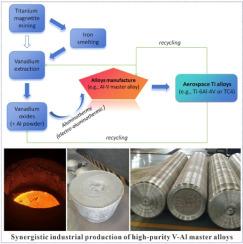Synergistic regulation of oxygen and nitrogen in V-Al master alloy for aerospace Ti alloys
IF 3.9
2区 材料科学
Q2 MATERIALS SCIENCE, MULTIDISCIPLINARY
引用次数: 0
Abstract
Vanadium and its alloys, including the widely known vanadium-aluminum (V-Al) alloy, are among the most promising materials for high-performance structural and functional applications. The structure and performance of V-Al alloys are significantly influenced by impurity elements. This study systematically analyzed the occurrence forms of oxygen (O) and nitrogen (N) impurities in V-Al alloys and investigated their sources. A synergistic regulation approach (“aluminothermy + electric heating + vacuum refining”) was implemented in industrial-scale production to control the impurity levels of O and N in the alloy, leading to the development of optimized methods for impurity control. The results reveal that the oxygen in V-Al alloys predominantly exists in the form of Al2O3, while nitrogen is primarily found as VN. Via tuning the CaO content in the slag and further vacuum refining as well as controlling the microscopic inclusion phases, the O and N content in the alloy can be effectively regulated. These findings provide valuable insights for the industrial production and optimization of V-Al alloys, particularly for high-end applications in the aerospace and biomedical sectors.

航空钛合金用钒铝中间合金中氧、氮的协同调节
钒及其合金,包括众所周知的钒铝(V-Al)合金,是高性能结构和功能应用中最有前途的材料之一。杂质元素对V-Al合金的组织和性能有显著影响。本文系统分析了钒铝合金中氧(O)和氮(N)杂质的赋存形式,并对其来源进行了探讨。在工业规模生产中实施了协同调节方法(“铝热+电加热+真空精炼”)来控制合金中O和N的杂质水平,从而开发了优化的杂质控制方法。结果表明:V-Al合金中氧主要以Al2O3的形式存在,氮主要以VN的形式存在;通过调整渣中CaO含量,进一步真空精炼,控制微观夹杂相,可以有效调节合金中的O和N含量。这些发现为V-Al合金的工业生产和优化提供了宝贵的见解,特别是在航空航天和生物医学领域的高端应用。
本文章由计算机程序翻译,如有差异,请以英文原文为准。
求助全文
约1分钟内获得全文
求助全文
来源期刊

Vacuum
工程技术-材料科学:综合
CiteScore
6.80
自引率
17.50%
发文量
0
审稿时长
34 days
期刊介绍:
Vacuum is an international rapid publications journal with a focus on short communication. All papers are peer-reviewed, with the review process for short communication geared towards very fast turnaround times. The journal also published full research papers, thematic issues and selected papers from leading conferences.
A report in Vacuum should represent a major advance in an area that involves a controlled environment at pressures of one atmosphere or below.
The scope of the journal includes:
1. Vacuum; original developments in vacuum pumping and instrumentation, vacuum measurement, vacuum gas dynamics, gas-surface interactions, surface treatment for UHV applications and low outgassing, vacuum melting, sintering, and vacuum metrology. Technology and solutions for large-scale facilities (e.g., particle accelerators and fusion devices). New instrumentation ( e.g., detectors and electron microscopes).
2. Plasma science; advances in PVD, CVD, plasma-assisted CVD, ion sources, deposition processes and analysis.
3. Surface science; surface engineering, surface chemistry, surface analysis, crystal growth, ion-surface interactions and etching, nanometer-scale processing, surface modification.
4. Materials science; novel functional or structural materials. Metals, ceramics, and polymers. Experiments, simulations, and modelling for understanding structure-property relationships. Thin films and coatings. Nanostructures and ion implantation.
 求助内容:
求助内容: 应助结果提醒方式:
应助结果提醒方式:


